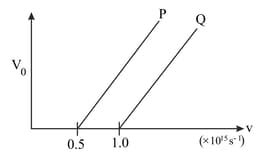Embibe Experts Solutions for Chapter: Dual Nature of Radiation and Matter, Exercise 1: Exercise
Embibe Experts Physics Solutions for Exercise - Embibe Experts Solutions for Chapter: Dual Nature of Radiation and Matter, Exercise 1: Exercise
Attempt the practice questions on Chapter 11: Dual Nature of Radiation and Matter, Exercise 1: Exercise with hints and solutions to strengthen your understanding. Physics Crash Course (Based on Revised Syllabus-2023) solutions are prepared by Experienced Embibe Experts.
Questions from Embibe Experts Solutions for Chapter: Dual Nature of Radiation and Matter, Exercise 1: Exercise with Hints & Solutions
The following graph shows the variation of stopping potential with frequency of the incident radiation for two photosensitive metals and :

Which metal,
(i) has smaller threshold wavelength.
(ii) has smaller kinetic energy.
Factors on which the stopping potential depends upon?
To observe photo-electric effect the frequency of incident light should be more than which frequency?
What is photo-electric effect?
For a certain metal threshold wavelength is . Calculate the work function of the metal.
When a metallic surface is illuminated with light of frequency the maximum kinetic energy of emitted electrons is . When the same surface is illuminated by light of frequency the maximum kinetic energy of emitted electrons is . Find out work function of the metal.
What is thermionic emission?
What is thermionic emission? Name two factors on which thermionic emission depends.
